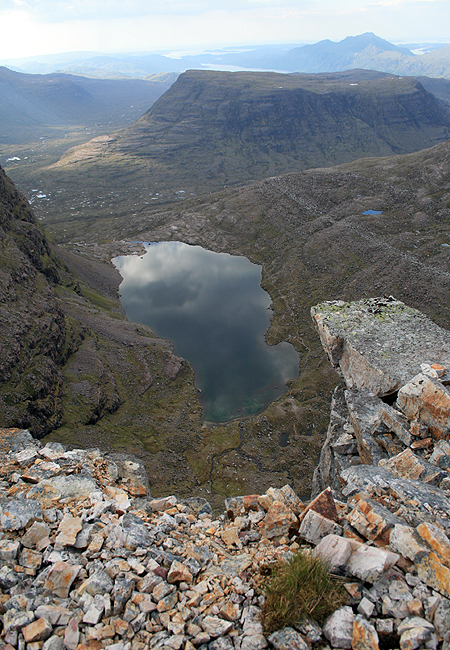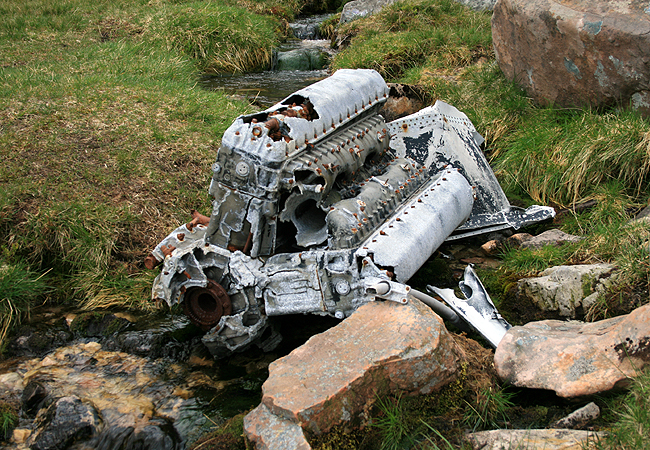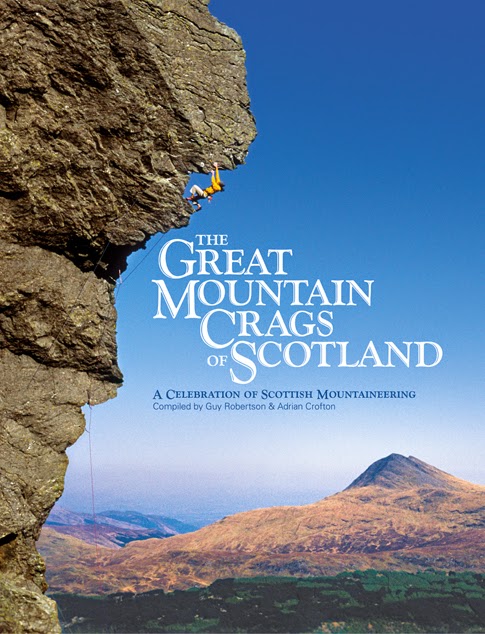Beinn Eighe

Those of you who maybe read these wee ramblings on stones might think I'm a boulderer through and through, but really the bulk of my climbing has been done on the Scottish mountains and crags - despite continually hunting new bouldering in remote areas, I do put on the harness and get some trad action done. I also feel it is important to understand the histories in our landscapes and sometimes this leads to humbling discoveries...
We had pulled together a posse that was supposed to gather in Skye to look at the new route possibilities around Sgurr a Ghreadaidh (highlighted recently by Dave Birkett's new E7/8 on an immaculate 100m wall of gabbro). The weather put paid to that: Es, Guy and Tim upped sticks to sunny Wales and left Ade and I to risk the NW... which turned out to reward us with some fine climbing.
Beinn Eighe is one of Scotland's most awesome ranges, with its gob-smacking series of north-facing corries and tiered cliffs of sandstone and quartzite. The first sign of the size of the range is apparent from Achnasheen as you head along the ridiculously fast new road to Kinlochewe. The grey skirts of scree tumbling from Beinn Eighe's summits look lunar in the deep blue sky - it's like you've caught a glimpse of the mountains of the moon. For someone who loves stone, its geology is fascinating - Torridonian Sandstone, 1000 m years old at its root, rising in cake-slice tiers to be capped by the 'icing' of strikingly white quartzite, half its age and shattering into leaning towers of rock on the summit... this is the rock which throws down the white scree and leaves odd purply white cubes amongst the red sandstone boulders in the corrie floor.

The view from the belays is continually fascinating...the corrie lochan reflects clouds, the distant mouth of Loch Maree can be seen (once a sea-loch in geological time), as well as tops of Beinn Lair and A Mhaighdean ('the maiden' - pronounced 'A Vadjin'). We climbed the Central Buttress via some wet sandstone grooves, then took a finish through the steep cracks and aretes at the top of the quartzite tower. Topping out directly onto the grassy alps of the summit, studded with clumps of mountain thyme, the views south were just as impressive... Sgurr Ruadh's slanting winter cliffs poking up on the south skyline, as well as the whole jagged back of Liathach in our foreground.
The oddest and saddest moments of any day on Beinn Eighe's buttresses is stumbling through the pretty coloured scree on the approach to Central Buttress and finding twisted shards of plane wreckage - great rubber wheels overgrown with moss, the burn running through the rusted innards of giant Merlin engines, the mangled remains of aluminium superstructure... these are the echoes of the last moments of a Lancaster Bomber... what was the story?

On the 13th March 1951, a converted Lancaster TX264 Bomber left RAF Kinloss on a reconnaissance training run through the western highlands. In the early hours of the 14th, it must have flown over the lip of Coire Mhic Fhearchair, maybe the pilot Harry Reid felt a surge of apprehension at the glacial nature of the loch (for anyone familiar with geology this could only mean one thing: you were surrounded by mountain cliffs). Ahead of them across the short loch were the shadowy triple buttresses which rise sheer out of the corrie for a thousand feet - an impossible obstacle for a lumbering Lancaster to surmount. The bomber made an effort to clear the obstacle but hit the top of the right buttress and all on board perished. It took the joint rescue services four months to recover the eight crew members' bodies, hampered by winter weather and the sheer inaccessibility of what is now the Grade 1 winter climb 'Fuselage Gully'. Perhaps out of respect for the dead, the plane was eventually blown up with explosives to scatter the wreckage.
The story of the rescue of the crew's bodies is a forgotten tale of bravery and determination. There were no National Trust mountain paths in those days and the approach was from Kinlochewe Village Hall (the rescue headquarters), a full 9 miles away around the remorseless mass of Beinn Eighe. On top of that, the crash-site itself was over 3000 feet altitude, in full winter condition. Joss Gosling, an RAF sergeant, was 22 at the time, and despite the lack of support from the RAF, he led volunteers into the Coire many times between the accident until the final body was recovered on July 4th... interestingly the snow was heavy until that date and still hampering the rescue climbers - these days our winters are nowhere near as long or cold on the mountains. The persistence of the independently co-ordinated rescue party highlighted the need for a proper rescue body - the RAF eventually set up an official rescue service which we rely on to this day should things go awry in the mountains.
So, if you are climbing on Beinn Eighe, spare a thought for the dead... they fought a war so we could climb in peace.
And yes, I did find some good bouldering!
We had pulled together a posse that was supposed to gather in Skye to look at the new route possibilities around Sgurr a Ghreadaidh (highlighted recently by Dave Birkett's new E7/8 on an immaculate 100m wall of gabbro). The weather put paid to that: Es, Guy and Tim upped sticks to sunny Wales and left Ade and I to risk the NW... which turned out to reward us with some fine climbing.
Beinn Eighe is one of Scotland's most awesome ranges, with its gob-smacking series of north-facing corries and tiered cliffs of sandstone and quartzite. The first sign of the size of the range is apparent from Achnasheen as you head along the ridiculously fast new road to Kinlochewe. The grey skirts of scree tumbling from Beinn Eighe's summits look lunar in the deep blue sky - it's like you've caught a glimpse of the mountains of the moon. For someone who loves stone, its geology is fascinating - Torridonian Sandstone, 1000 m years old at its root, rising in cake-slice tiers to be capped by the 'icing' of strikingly white quartzite, half its age and shattering into leaning towers of rock on the summit... this is the rock which throws down the white scree and leaves odd purply white cubes amongst the red sandstone boulders in the corrie floor.

The view from the belays is continually fascinating...the corrie lochan reflects clouds, the distant mouth of Loch Maree can be seen (once a sea-loch in geological time), as well as tops of Beinn Lair and A Mhaighdean ('the maiden' - pronounced 'A Vadjin'). We climbed the Central Buttress via some wet sandstone grooves, then took a finish through the steep cracks and aretes at the top of the quartzite tower. Topping out directly onto the grassy alps of the summit, studded with clumps of mountain thyme, the views south were just as impressive... Sgurr Ruadh's slanting winter cliffs poking up on the south skyline, as well as the whole jagged back of Liathach in our foreground.
The oddest and saddest moments of any day on Beinn Eighe's buttresses is stumbling through the pretty coloured scree on the approach to Central Buttress and finding twisted shards of plane wreckage - great rubber wheels overgrown with moss, the burn running through the rusted innards of giant Merlin engines, the mangled remains of aluminium superstructure... these are the echoes of the last moments of a Lancaster Bomber... what was the story?

On the 13th March 1951, a converted Lancaster TX264 Bomber left RAF Kinloss on a reconnaissance training run through the western highlands. In the early hours of the 14th, it must have flown over the lip of Coire Mhic Fhearchair, maybe the pilot Harry Reid felt a surge of apprehension at the glacial nature of the loch (for anyone familiar with geology this could only mean one thing: you were surrounded by mountain cliffs). Ahead of them across the short loch were the shadowy triple buttresses which rise sheer out of the corrie for a thousand feet - an impossible obstacle for a lumbering Lancaster to surmount. The bomber made an effort to clear the obstacle but hit the top of the right buttress and all on board perished. It took the joint rescue services four months to recover the eight crew members' bodies, hampered by winter weather and the sheer inaccessibility of what is now the Grade 1 winter climb 'Fuselage Gully'. Perhaps out of respect for the dead, the plane was eventually blown up with explosives to scatter the wreckage.
The story of the rescue of the crew's bodies is a forgotten tale of bravery and determination. There were no National Trust mountain paths in those days and the approach was from Kinlochewe Village Hall (the rescue headquarters), a full 9 miles away around the remorseless mass of Beinn Eighe. On top of that, the crash-site itself was over 3000 feet altitude, in full winter condition. Joss Gosling, an RAF sergeant, was 22 at the time, and despite the lack of support from the RAF, he led volunteers into the Coire many times between the accident until the final body was recovered on July 4th... interestingly the snow was heavy until that date and still hampering the rescue climbers - these days our winters are nowhere near as long or cold on the mountains. The persistence of the independently co-ordinated rescue party highlighted the need for a proper rescue body - the RAF eventually set up an official rescue service which we rely on to this day should things go awry in the mountains.
So, if you are climbing on Beinn Eighe, spare a thought for the dead... they fought a war so we could climb in peace.
And yes, I did find some good bouldering!


